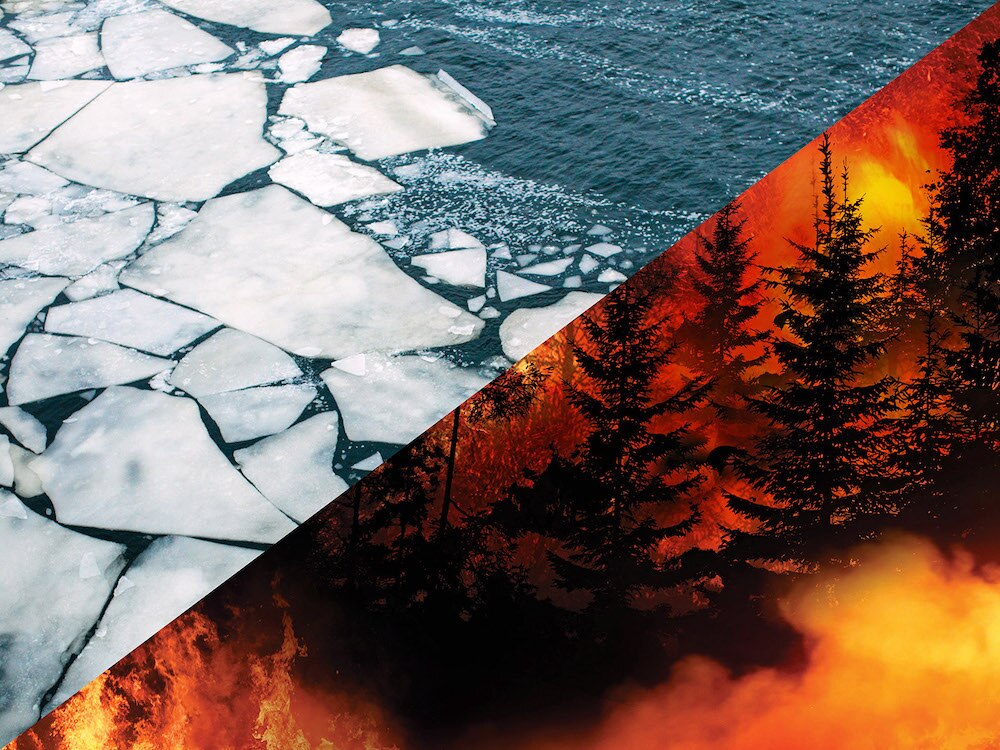Create a free profile to get unlimited access to exclusive videos, sweepstakes, and more!
A song of ice and fire: How shrinking arctic ice worsens wildfires
Our ice shields are falling and the fire is rising.

The rising global temperatures resulting from climate change don’t just mean fewer days wearing a winter coat, it also means more wildfires. The increase in wildfires has been a consistent problem in the western United States, and the data suggests it’s getting worse year over year and decade after decade.
Scientists had observed a correlation between the number and severity of wildfires and the decline of sea ice in the arctic. As arctic sea ice shrank, wildfires in the western United States increased, but it wasn’t clear how floating ice hundreds of miles away might be driving the formation of fires in North America. It wasn’t even clear if there was a causative relationship at all, or if the two were co-evolving phenomenon driven by higher average temperatures.
A new study by Hailong Wang from the Atmospheric Sciences and Global Change Division at the Pacific Northwest National Laboratory, and colleagues, builds a case for the way declining sea ice drives the emergence of wildfires farther south. The results were published in the journal Nature Communications.
“It wasn’t all that surprising,” Wang told SYFY WIRE. “We had some earlier studies indicating a relationship. In our study, we used our unique tool to verify and discover the mechanism.”
The tool in question is a new climate model which allowed scientists to input several variables, including the level of arctic sea ice, to find the impact on fire weather. Using observational data sets for previous decades, the team plugged in those variables and confirmed that their model accurately determined wildfires for a given year.
“The model can actually predict fire occurrence and burn area. We prescribed the ice reduction and can see how all the climate processes respond to that reduction. We found a step-by-step mechanism shows up in the model results,” Wang said.
The mechanism flowing from reduced arctic sea ice to California wildfires is called teleconnection and, like everything related to weather and climate systems, it’s a little complex. In a broad sense, the team found that melting sea ice has an impact on two atmospheric pressure systems they call vortexes.
Sea ice is really good at reflecting sunlight away from the planet, but when there’s less ice, more of that heat enters the water and raises temperatures. That warm air rises from the ocean surface and strengthens the first vortex in the arctic. In turn, that vortex pushes southward and changes the course of the polar Jetstream. Next, the second vortex forms over the western United States bringing warm, dry air to the surface. As a result, the environment becomes more favorable to wildfires. In essence, sea ice was acting as a shield wall, protecting North America from fire, and that wall is falling.
This study focused on the Northern Hemisphere, but it’s possible similar relationships exist in the south. Certainly, wildfires are a concern in the Southern Hemisphere as well, as evidenced by the massive fires in Australia in early 2020.
“The Southern Hemisphere is quite different. The structure of the Jetstream and the persistent ice sheet over Antarctica make it very different. There might be some similar teleconnection mechanisms, but we haven’t studied that yet,” Wang said.
While sea ice is a contributing factor for those of us in the western U.S., weather is complex, and this new model may not be sufficient for predicting future fires if one or several of the other factors don’t play out as we expect.
“There is also natural climate variability like the El Niño-Southern Oscillation (ENSO) which impacts precipitation over many regions. There are also factors like ignition source. Sometimes that’s human mistakes, or lightning. If those factors change, it’s hard to say how it will interact with this one factor,” Wang said.
What seems to be clear from the models is, regardless of other variables, shrinking sea ice quite literally adds fuel to the fire, increasing the need for human intervention wherever possible. As arctic sea ice continues to melt as a result of anthropogenic climate change, fire risk will continue to rise.
“We hope this serves as motivation for adaptive approaches and public awareness of the risk,” Wang said. “Hopefully forest management will come up with some actions for hazard mitigation or even plan more sustainable residential infrastructure development.”
Those are good strategies for avoiding or handling the fires which will inevitably come, but this work suggests that the real culprit is our ever-warming planet.
It’s in our best interests to address the root of the problem, halting and reversing the effects of fossil fuel burning so we can rebuild our arctic shield wall.

























